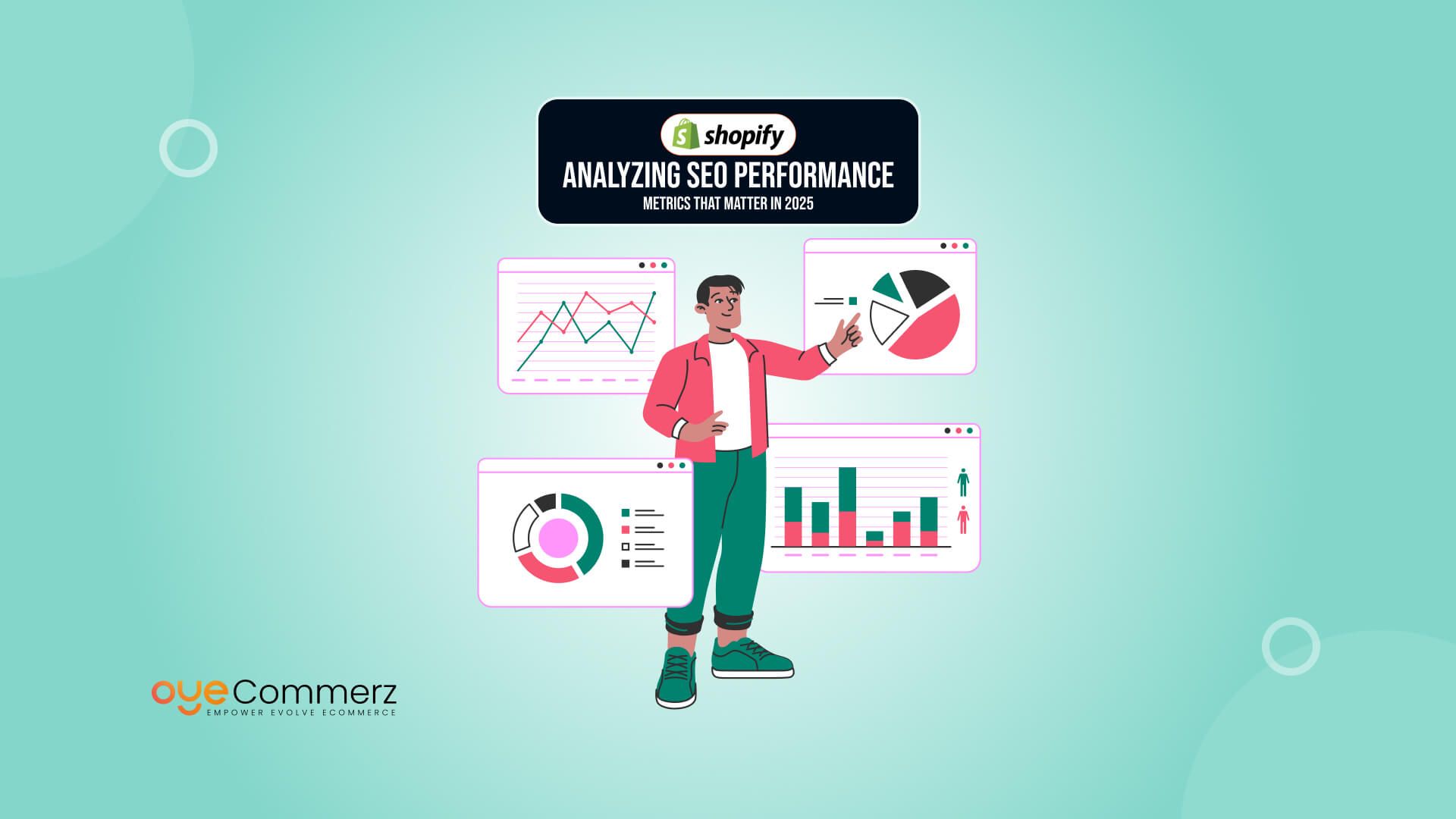Is your Shopify SEO strategy actually working, or are you just watching traffic without knowing what drives results?According to Statista, organic search continues to be the top traffic source for global eCommerce, accounting for over 32% of visits across industries. Yet, many Shopify merchants pour resources into SEO without measuring what truly matters. They focus on surface-level metrics like pageviews or rankings, missing deeper signals like intent, quality, and performance alignment.
This guide explores essential SEO performance metrics every Shopify store should track in 2025 while analyzing Shopify SEO performance from both a technical and strategic lens. When measured right, SEO becomes less guesswork and more of a scalable growth engine.
Table of Contents
ToggleShopify SEO Performance - A Modern-Day Necessity
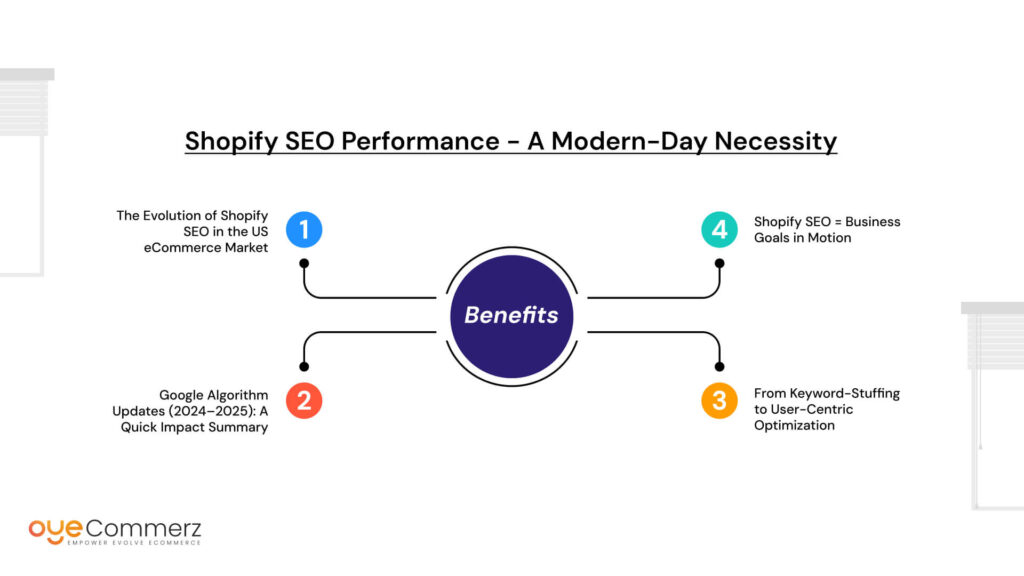
Shopify SEO performance isn’t just a traffic lever, it’s a strategic driver of qualified growth. As organic search continues to dominate consumer behavior, Shopify businesses can’t afford to treat SEO as an afterthought. The way SEO operates within the Shopify ecosystem has evolved dramatically over the last few years, especially with algorithmic shifts and rising expectations for user intent and experience.
The Evolution of Shopify SEO in the US eCommerce Market
- Search behavior has matured: US consumers now rely on richer, more specific search queries,often transactional or intent-driven, increasing the need for semantic content and structured data.
- Mobile-first indexing is now the default: Shopify themes and stores must now prioritize mobile UX, page speed, and Core Web Vitals to maintain visibility.
- Voice and conversational search have reshaped keyword targeting: Shopify SEO is no longer about stuffing keywords; it’s about answering questions and matching user expectations.
Google Algorithm Updates (2024–2025): A Quick Impact Summary
- March 2024 Core Update: Google emphasized devaluing low-quality, AI-generated, and thin content, impacting many Shopify blogs and product pages.
- Helpful Content System Enhancements: Sites lacking original value or demonstrating over-optimization experienced ranking volatility. This forced Shopify brands to align with experience, expertise, authoritativeness, and trustworthiness (E-E-A-T) signals.
- Search Generative Experience (SGE): With AI-driven summaries appearing on search results, structured content and schema implementation became crucial for visibility.
From Keyword-Stuffing to User-Centric Optimization
Old tactics like stuffing exact-match keywords or duplicating product descriptions across SKUs are now detrimental. Shopify SEO in 2025 demands:
- Value-driven product pages with unique content, FAQs, and buyer intent mapping
- Content designed for humans first, not search engines
- Rich metadata and structured markup for visibility in AI-enhanced SERPs
This shift has forced Shopify store owners to reframe SEO from a “traffic tool” to a conversion architecture, one built around usability, engagement, and performance signals.
Shopify SEO = Business Goals in Motion
Effective Shopify SEO now touches every business outcome:
- Visibility: Are your key products and categories discoverable in non-branded search?
- Traffic: Are you attracting qualified users based on search intent?
- Conversions: Are those users becoming customers, and how does SEO support the funnel?
Modern Shopify SEO must align with overarching KPIs, not just rank on page one. It should inform decisions around merchandising, UX design, and even email strategy.
SEO Performance Metrics: Tracking the Right Signals
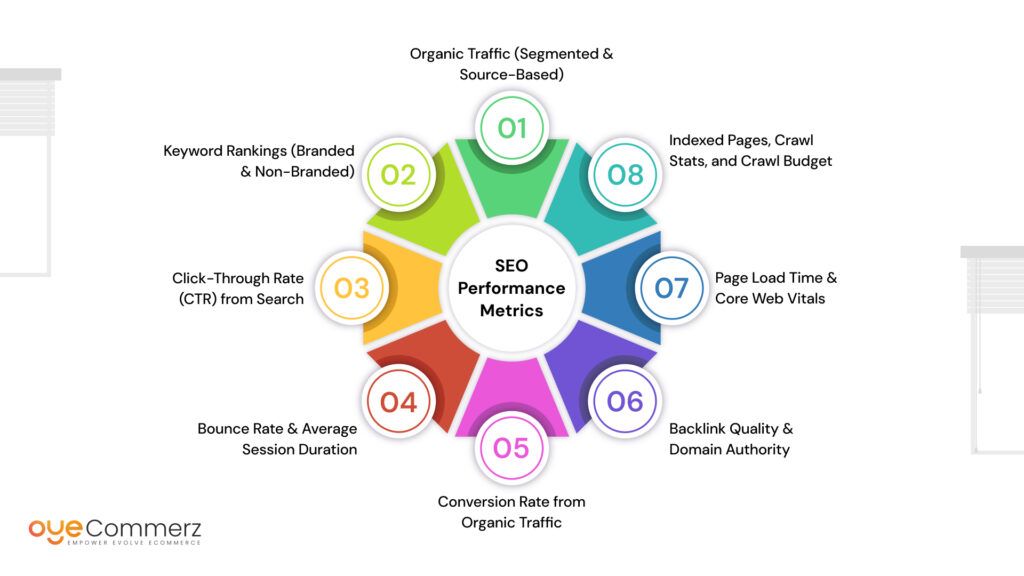
Many Shopify store owners equate rising traffic with SEO success, but that’s only a fragment of the truth.
Traffic alone doesn’t reveal who’s coming, why they’re visiting, or what they’re doing once they land. You might be celebrating 20K monthly visits, yet struggling to convert. Or you could be ranking for irrelevant keywords, drawing users who bounce within seconds.
This is where SEO performance metrics take the lead. They decode what’s working, what’s misleading, and what’s silently underperforming, offering a real-time health report of your Shopify store’s visibility, engagement, and ROI.
Here are the 8 essential SEO performance metrics every Shopify merchant should track in 2025 for growth that’s measurable and meaningful:
1. Organic Traffic (Segmented & Source-Based)
Why It Matters: Organic traffic forms the foundation of SEO success, but without segmentation, insights remain vague.
What to Track:
- Breakdown of traffic by landing pages (via GA4)
- Segment by device type (mobile vs. desktop)
- Compare sources: organic, direct, referral
Sample Traffic Segmentation Metrics
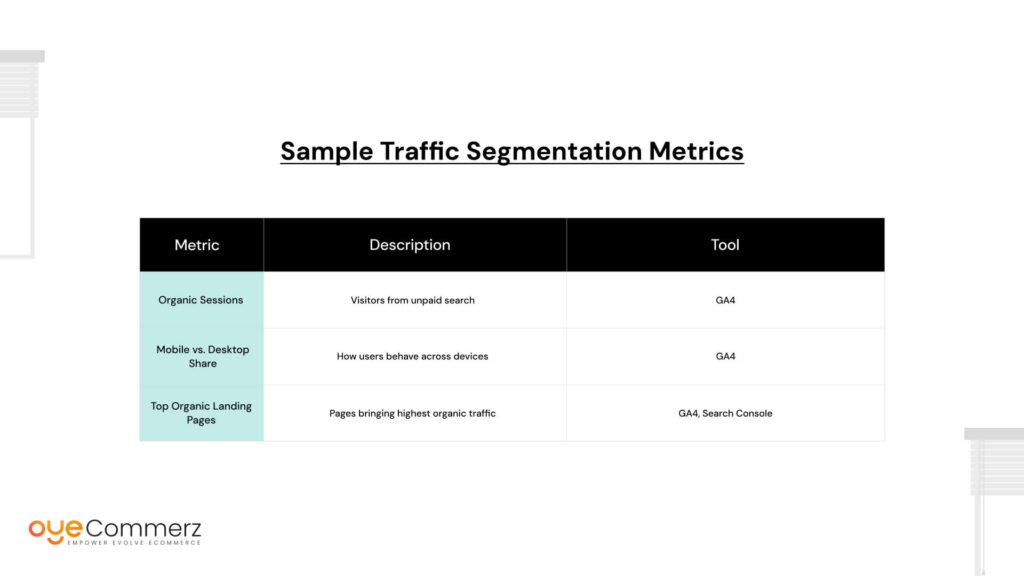
Segmenting traffic helps uncover patterns. For instance, if mobile users bounce more often on a product page, it’s a UI issue, not an SEO flaw.
2. Keyword Rankings (Branded & Non-Branded)
Why It Matters: Rankings indicate visibility, but tracking keyword categories reveals targeting accuracy.
Best Practices:
- Segment keywords into:
- Product keywords (e.g., “organic baby shampoo”)
- Informational keywords (e.g., “how to use baby shampoo”)
- Brand keywords (e.g., “OyeCommerz shampoo review”)
- Use tools like Semrush, Ahrefs, or Nightwatch to monitor SERP movement.
Weekly ranking audits ensure that SEO efforts are aligned with user demand and content gaps.
3. Click-Through Rate (CTR) from Search
Why It Matters: Ranking doesn’t always equal clicks. CTR shows if your titles and meta descriptions compel action.
How to Use It:
- Check GSC Performance Reports for high-impression, low-CTR pages
- Revise titles/meta descriptions for clarity, emotional pull, and keyword placement
- Benchmark against Shopify industry averages (average eCommerce CTR: ~2–4%)
Pages that rank but don’t earn clicks are opportunities for metadata optimization, a quick win for engagement.
4. Bounce Rate & Average Session Duration
Why It Matters: Not all bounces are bad, but understanding intent mismatch is key.
Interpretation Tips:
- High bounce + low session time = poor content alignment
- High bounce + long session = user might have found their answer quickly (e.g., contact page)
Action Points:
- Improve on-page design: compress layout, enhance scannability
- Add multimedia and interactive elements to extend session time
- Make sure CTAs are above the fold and aligned with search intent
These engagement metrics signal whether your SEO content satisfies user expectations, or frustrates them.
5. Conversion Rate from Organic Traffic
Why It Matters: Traffic that doesn’t convert is expensive noise.
GA4 Tactics:
- Set up custom funnels to isolate organic sessions
- Track actions like add-to-cart, checkout initiation, email signups
- Compare conversion rates across traffic sources
Focus on SEO-priority pages, such as top-performing blog posts or category pages, and enhance them with better UX, persuasive copy, or trust signals like reviews and guarantees.
6. Backlink Quality & Domain Authority
Why It Matters: High-authority, relevant backlinks boost both trust and SERP visibility, especially for new Shopify sites.
Key Actions:
- Prioritize backlinks from industry-relevant publications or influencers
- Avoid spammy, irrelevant links, and disavow them through Google if needed
- Use tools like Ahrefs, Moz, or Majestic to track referring domains and DA changes
In 2025, link quality > quantity. A single link from a trusted niche blog can outperform 50 low-grade directory listings.
7. Page Load Time & Core Web Vitals
Why It Matters: Speed is no longer optional. Google’s Core Web Vitals are integrated into ranking algorithms, especially for mobile search.
Focus Metrics:
- LCP (Largest Contentful Paint) – How fast the main content loads
- CLS (Cumulative Layout Shift) – Visual stability of the page
- FID (First Input Delay) – Responsiveness of the site
Optimization Tactics:
- Compress large media files and enable lazy loading
- Use fast, lightweight Shopify themes
- Eliminate unnecessary third-party scripts and apps
Pages that load fast retain users longer and improve conversion rates, a direct impact on SEO ROI.
8. Indexed Pages, Crawl Stats, and Crawl Budget
Why It Matters: Google’s crawler time is limited. Ensuring the right pages are indexed means better SEO returns.
Checklist for Crawl Optimization:
- Use GSC Index Coverage Report to spot:
- Soft 404s
- Redirect chains
- Blocked resources
- Remove or no index:
- Duplicate content (e.g., variants with minimal difference)
- Out-of-stock or discontinued product pages
- Monitor crawl stats to see how frequently Google visits key URLs
Remove unnecessary URLs regularly to free up crawl budget for high-value content.
Analyzing Shopify SEO: Tools That Enable Data-Driven Growth
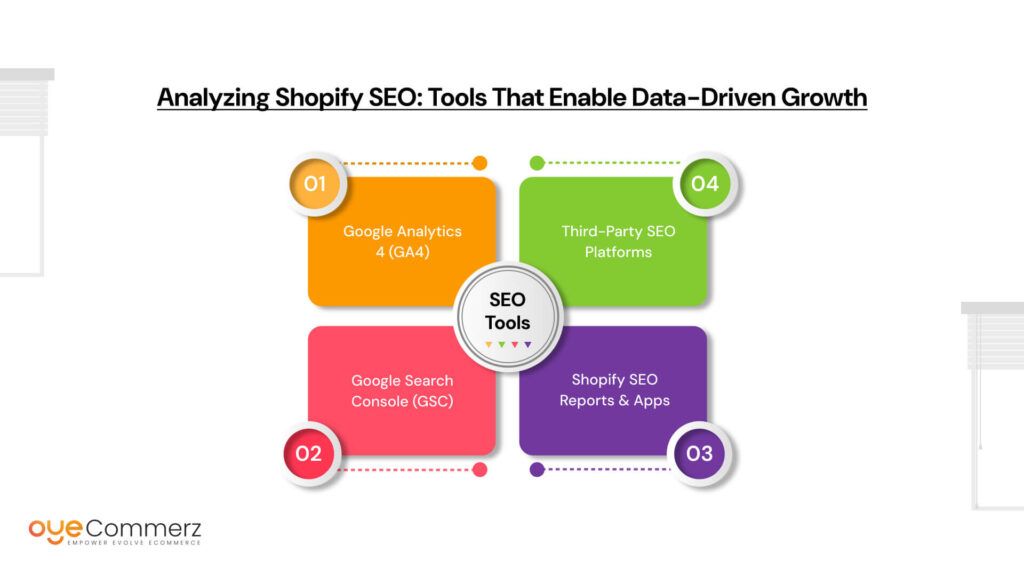
For all its robust eCommerce features, Shopify’s native dashboard falls short when it comes to deep SEO tracking.
Sure, you can monitor sales and traffic sources, but what about detailed keyword performance, indexing errors, or declining impressions? If you rely solely on Shopify’s out-of-the-box analytics, you’re likely missing critical signals, like keyword cannibalization, technical crawl issues, or low-converting high-traffic pages.
To build an SEO strategy that’s growth-driven, you need to integrate Google’s native tools with powerful third-party SEO platforms. Let’s break down the most effective tools to analyze, optimize, and scale your Shopify store’s search performance in 2025.
1. Google Analytics 4 (GA4)
Why Use It: GA4 is essential for connecting SEO insights to real business outcomes like sales and user behavior.
Key Features for SEO:
- Track organic traffic by landing page to see which URLs drive the most unpaid visits.
- Monitor conversion paths that originate from search, including purchases, add-to-carts, and newsletter sign-ups.
- Use the “Exploration” module to study how users move through your site from organic search, e.g., homepage → collection page → product page.
- Build custom dashboards filtered to only organic users to monitor their engagement, behavior, and conversion rate.
By connecting SEO to revenue (not just rankings), GA4 helps prioritize which pages to optimize first.
2. Google Search Console (GSC)
Why Use It: GSC gives you a direct line to how Google views and indexes your store.
Key Features:
- The Performance tab shows impressions, clicks, CTR, and average positions, all segmented by page, country, or device.
- Identify opportunity pages: high impressions but low CTR = weak meta copy; low impressions = poor indexing or low authority.
- Use Coverage Reports to find:
- Soft 404s (pages that look broken but aren’t)
- Crawl anomalies
- Excluded pages you want indexed
- The URL Inspection Tool helps diagnose real-time indexing issues or structured data errors on specific pages.
GSC is especially powerful when paired with a content refresh strategy, allowing you to reoptimize underperforming pages with data-backed precision.
3. Shopify SEO Reports & Apps
Why Use Them: While Shopify doesn’t offer in-depth SEO metrics natively, its ecosystem of apps fills that gap.
Recommended Tools:
- Plug in SEO, Smart SEO, or SEO Manager provide easy-to-read reports on:
- Missing or duplicate meta titles/descriptions
- Broken links
- Image alt-text issues
- Structured data gaps
- Many apps offer automated weekly audits and suggestions you can act on without leaving your Shopify dashboard.
- Customize SEO fields per product or collection, allowing you to manually override default meta settings and write search-optimized copy for every page.
These apps bridge the gap between Shopify’s content system and technical SEO needs, perfect for non-technical store owners.
4. Third-Party SEO Platforms
These tools go beyond basic reporting and offer enterprise-level analysis to outperform competitors:
Ahrefs
- Discover new keywords and track rankings
- Monitor backlink health and quality
- Use the Content Gap tool to identify what your competitors rank for that you don’t
Semrush
- Offers in-depth position tracking, site health audits, and topic research tools
- Helps plan and optimize content for both product and blog pages
- Includes SEO Writing Assistant to improve content readability and keyword usage
Screaming Frog SEO Spider
- A technical SEO powerhouse for crawling your entire Shopify site
- Find duplicate content, redirect chains, missing tags, and orphan pages
- Export crawl data to filter and prioritize SEO fixes
These platforms are ideal for in-house marketers or agencies managing larger stores with thousands of SKUs and competing keywords.
No single tool covers it all. The key is integration, use GA4 for performance tracking, GSC for visibility diagnostics, Shopify SEO apps for hands-on fixes, and advanced tools like Ahrefs or Semrush for strategy.
Shopify SEO Performance Reporting for Scalable Optimization
Collecting SEO data is only the first step. The real challenge lies in translating that data into actionable strategies.
Most Shopify store owners and marketers gather analytics; traffic, rankings, backlinks, but fail to connect those numbers to business outcomes. As a result, teams waste time fixing low-impact issues, miss key optimization cycles, and lack clarity on what’s actually driving growth.
To break this cycle, you need to build structured, monthly SEO reporting frameworks that highlight performance, reveal opportunities, and guide decision-making. These reports serve as your SEO blueprint, allowing you to optimize at scale with precision and confidence.
What to Include in Shopify SEO Reports
A strong SEO report isn’t just a data dump. It should answer a simple question: What’s working, what’s not, and what’s next?
Here are the key elements to include:
Essential KPIs
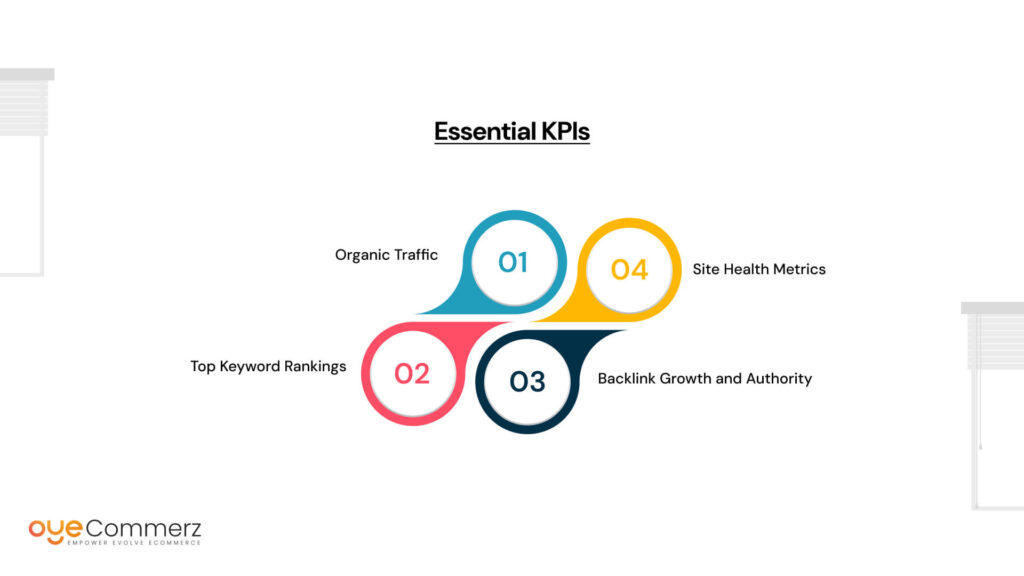
- Organic Traffic (segmented by page and source)
- Top Keyword Rankings (branded and non-branded)
- Backlink Growth and Authority
- Site Health Metrics: Page speed, Core Web Vitals
Business Outcomes
- Organic Revenue: How much income came from unpaid search
- Conversion Rate from Organic Users
- Customer Acquisition Cost (CAC) via SEO
Sample Monthly SEO Report Overview
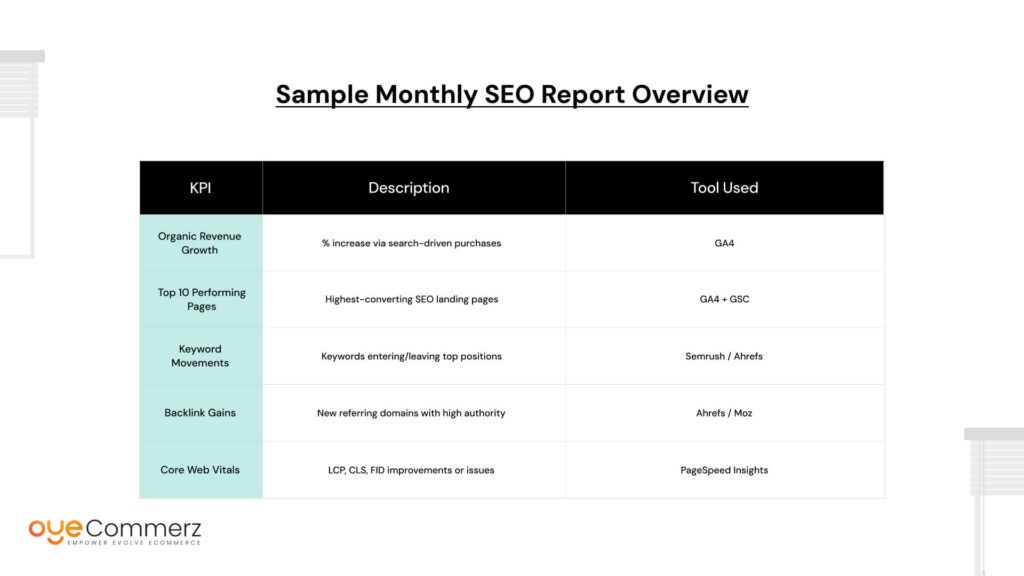
Make your reports visual and digestible. Charts, tables, and color-coded metrics help stakeholders instantly understand where to focus.
2. Setting Performance Benchmarks
SEO is a long game, but tracking monthly progress ensures you don’t fall behind.
How to Set Benchmarks
- Traffic Growth: Set a baseline monthly growth target (e.g., +8–10%)
- Ranking Milestones: Aim for X% of target keywords in top 10
- Conversion Rate: Benchmark against past performance or industry averages
Adjusting for Seasonality
- Use Google Trends and Shopify analytics to understand demand cycles
- Realign SEO priorities during:
- Sales periods (e.g., Black Friday)
- Product launches
- Low-season slumps
Benchmarks help teams stay realistic and course-correct early when progress stalls.
3. Actioning Insights from Reports
A great SEO report ends with action, not just analytics.
Create SEO Sprints Based on Insights
- Content Optimization: Identify blog/product pages with high impressions but low CTR
- Technical Fixes: Highlight slow-loading pages or crawl errors
- Backlink Strategy: Focus on pages gaining authority vs. those needing outreach
Prioritize with Purpose
- Categorize action items:
Technical (page speed, indexing) - Content (meta titles, internal linking, keyword alignment)
- Links (building or disavowing)
Assign Ownership
- Designate team members or vendors for each task
- Set clear deadlines and next-review checkpoints
- Include KPIs to track the impact of each sprint
Example:
“Product category pages have high bounce and low time-on-page. Action: Update descriptions, improve CTAs, and run A/B testing. Assigned to the content team, deadline: July 30.”
Monthly SEO reporting isn’t about checking boxes, it’s about creating a feedback loop between data and execution. By reporting with context, setting smart benchmarks, and turning insight into action, Shopify brands can evolve SEO from a marketing function to a growth engine.
Applying SEO Performance Metrics to Improve Shopify Outcomes
Many Shopify store owners know their metrics, from bounce rates to keyword rankings, but struggle to translate that data into action. This leads to a frustrating loop: reporting results without making progress.
To break that loop, every SEO metric needs a clear optimization path. Here’s how to connect your performance data with real outcomes:
Content-Level Fixes
- Improve CTR: Rewrite meta titles/descriptions for low-CTR pages based on Search Console data.
- Reduce Bounce Rate: Add internal links to related products or blogs; restructure content using H1-H3 hierarchies and include user-intent-aligned FAQs.
- Enhance Content Depth: Use SERP competitor analysis to identify missing angles, formats, or topics.
Technical SEO Improvements
- Boost Core Web Vitals: Compress images, enable lazy loading, reduce render-blocking scripts.
- Fix Indexation Issues: Check for accidental noindex, resolve canonical tag conflicts, and ensure high-value pages are crawlable.
- Simplify Crawl Paths: Flatten complex Shopify category structures to prevent crawl depth issues.
Backlink & Authority Building
- Reclaim Lost Links: Audit 404 pages with previous backlinks and set up redirects.
- Outreach Strategy: Build relationships with niche publications and product reviewers for natural, relevant backlinks.
- Avoid Black-Hat Tactics: Say no to link farms and PBNs; focus on authority through value.
By tying each metric to a corresponding action, Shopify brands move from data paralysis to scalable SEO success.
Shopify SEO Performance in 2025 - Trends That Will Shape the Future
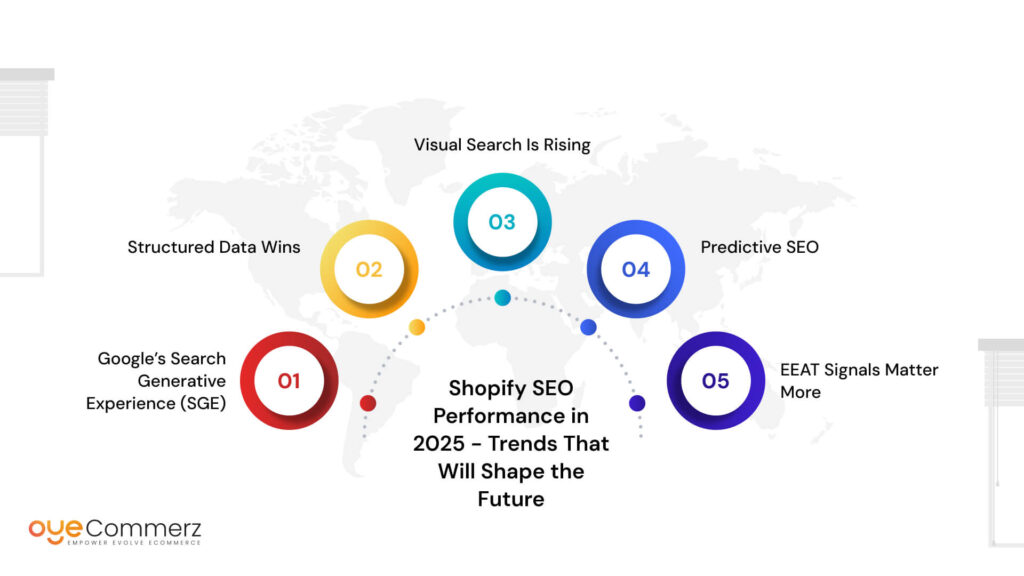
The SEO landscape is evolving rapidly, and Shopify merchants need to stay ahead of the curve. Here’s what’s shaping 2025:
- Google’s Search Generative Experience (SGE): AI-powered snippets may reduce CTR; optimizing for visibility within AI answers will be key.
- Structured Data Wins: Schema markup will be essential for rich results, reviews, FAQs, and product visibility.
- Visual Search Is Rising: Image optimization and meaningful alt-text will support both SEO and accessibility.
- Predictive SEO: AI tools will help forecast ranking potential before content is even published.
- EEAT Signals Matter More: Product pages with expert reviews, author credentials, and trust signals will rank higher.
The future is insight-driven, user-first, and AI-enhanced. Staying agile will be the biggest SEO advantage on Shopify.
Looking to take your Shopify store to the next level?
OyeCommerz offers expert Shopify services tailored to boost your traffic, sales, and online visibility. From SEO audits to conversion-optimized storefronts, we power your eCommerce growth with data-driven strategies.
Whether you’re launching or scaling, we’ve got the tools and talent to make it happen.
Let’s build something extraordinary, your success story starts with OyeCommerz.
Contact us now!
Contact to Migrate your Site to Shopify Now
Conclusion
To stay ahead in the highly competitive eCommerce landscape, Shopify businesses must go beyond surface-level analytics. Tracking organic traffic alone is no longer enough. The real growth lies in understanding user intent, identifying SEO bottlenecks, and optimizing with precision.
By leveraging key SEO performance metrics, from organic conversion rates to Core Web Vitals, you equip your store with the insight needed to drive smarter strategies and sustainable growth. Modern tools like GA4, GSC, and third-party platforms bridge the gap between raw data and real outcomes.
Effective Shopify SEO in 2025 is about measuring what matters, applying insights strategically, and building systems for continuous optimization.
Start tracking smarter, optimizing faster, and growing bigger, because in 2025, your Shopify SEO performance defines your competitive edge.
Frequently Asked Questions
Ahrefs and Semrush are among the best for advanced SEO, while Plug in SEO is great for Shopify-specific audits.
Yes, SEO is crucial for driving organic traffic, improving visibility, and increasing conversions on Shopify stores.
Optimize titles, meta descriptions, URLs, image alt-text, page speed, and use structured data. Regular audits help maintain SEO health.
Shopify includes basic SEO features, but advanced optimization may require third-party tools or apps.
Semrush is widely regarded as one of the most comprehensive and effective SEO tools for tracking, auditing, and keyword research.

